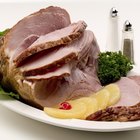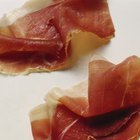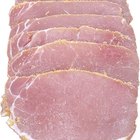Ham from the German region of the Black Forest is traditionally known as Black Forest Ham. The Black Forest is located in southwestern Germany -- near the town of Freiburg and several hundred miles west of Munich -- and is immensely popular with tourists thanks to its traditional German Alpine setting. Known locally as Schwarzwalder Schinken, Black Forest ham uses very specific production methods to develop its unique flavors.
Black Forest Ham
Black Forest ham has a distinctive red coloring and is marked with streaks of fat. A boneless ham, its meat is traditionally smoked when raw, giving it an instantly recognizable smoky flavor and aroma. Black Forest ham is also thoroughly cured with salt and then hung up to dry in a cool room, often in a linen bag. This method of preserving and storing allows the ham to keep for months.
Flavors
The name Black Forest ham does not simply refer to the meat’s area of production; it also refers to some very specific components of its flavor. The ham is smoked raw over a fire of fir branches cut from strictly Black Forest trees, giving it a unique flavor that ensures that a true Black Forest ham can always be identified over a ham produced elsewhere. Within the European Union, only hams produced within the Schwarzwalde can truly be called a Black Forest ham. However, this protection does not extend to the U.S., where hams bearing the Black Forest name maybe have originated from anywhere. Another major part of the ham’s flavor is the sawdust from the fir trees that is thrown on the fire to increase the smoke. This sawdust smoke enhances the color of the meat as well as the flavor.
Preparation
Despite the strict geographical restrictions on the production of Black Forest ham, the actual pigs used to produce the ham do not necessarily come from the Black Forest. The code of the Association of Black Forest Ham states that quality of ham takes precedence over geographical origin. The top quality ham from all over Germany is then brought to the Black Forest where it is checked for temperature, color and pH levels before being prepared by hand. At this stage, additives and spices such as salt, garlic, pepper, coriander and juniper berries are rubbed into the meat by hand. The ham is then salted in brine for two weeks before spending another two weeks in dedicated curing rooms. They hams are then transported to smoking towers, where they hang for three further weeks, accumulating their unique flavor.
Traditional Coating
Black Forest hams were traditionally coated with beef blood. This gave the ham its trademark black exterior. This practice has become less common as tradition gave way to modern market taste. To make the meat more palatable, producers will sometimes mimic the dark color of the ham with spices, even though there is a marked difference between the coloration of the two coatings. Traditionally made Black Forest ham retains this beef blood coating, which is evidenced by its external coloring.
Related Articles

Does Boiled Ham Have Nitrites?

Can I Eat Prosciutto Ham Without ...

How Do I Tell If Pork Has Turned Bad?
How Long Do You Smoke Ham Per Pound?

What Part of Beef Is Kosher?
The Difference Between a Spiral-Cut Ham ...

Cooking Instructions for a Ridge Creek ...

Uses of Saltpeter in Food

How to Store Uncooked Smoked Ham

How to Make Salt Brine

Different Kinds of Lunch Meat

Different Kinds of Cold Cuts

Can You Make Prosciutto

How Do I Roast a Picnic Ham?

What Kind of Ham to Use for a Boiled ...
What Cut of Meat Do You Use to Make ...

How Long Will Dry Salami Last if Not ...

The Effect of Salt on the Tenderness of ...
What Is the Difference Between Slab & ...

How Many Calories Are in Smoked Ham?
References
Writer Bio
Julia Salgado has been writing professionally since 2007. Her work has been published by the "Manchester Evening News" and "Q Magazine." Salgado holds a Bachelor of Arts in English from Manchester Metropolitan University.